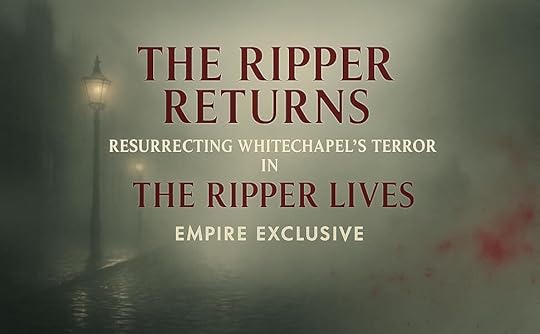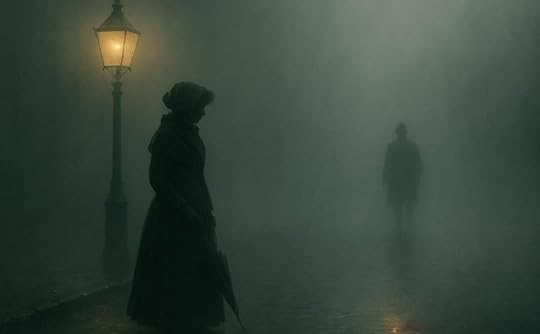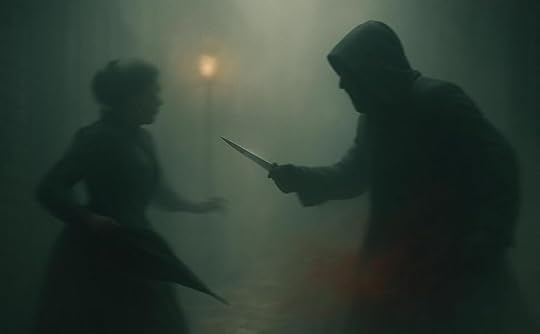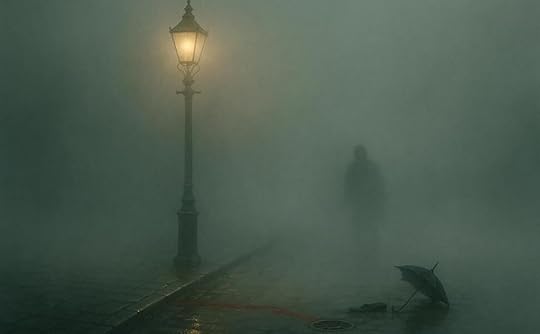The Ripper Returns: Resurrecting Whitechapel’s Terror in The Ripper Lives (Empire Exclusive)

Victorian London’s most infamous killer has been unmasked a hundred times in books and films, yet with each “solution”, Jack the Ripper lost a little of his menace. After 135 years of theories and pop-culture overexposure, one might think the phantom of Whitechapel has been rendered almost benign – a museum piece rather than a source of nightmares. “Naming the Ripper and uncovering his secrets has destroyed the enigma and rendered his menace impotent,” author Kevin Morris explains, referring to the many suspect reveals that have flattened the legend’s aura. So, in his new 10-part Victorian Gothic horror series The Ripper Lives, he set out on an unholy mission: to restore Jack the Ripper to the realm of nightmare and make modern readers feel the same dread that gripped Whitechapel in 1888. The result is a pulse-pounding historical thriller that doesn’t just retell the Ripper murders – it drags us, kicking and screaming, into the black heart of “Darkest London” to confront the monster anew.
Ghost in the Fog – Making Myth Scary Again
Why is Jack the Ripper still so compelling? Morris suggests it’s because the Ripper was never just a person – he was a myth, a mystery, a bogeyman born of fog and fear. “In the beginning, the Ripper was a ghost in the fog, whose proof of life was the bodies left in his wake,” the author explains. “His image was conjured from the dark recesses of the mind and shaped by trauma, which made him far more terrifying than any man of flesh and blood”. Unlike many modern novels that focus on whodunit puzzles or over-familiar conspiracy theories, The Ripper Lives leans into this original aura of uncertainty. The killer in Morris’s tale remains a shadowy, elusive presence – more a creeping dread than a flesh-and-blood criminal. By withholding the killer’s identity and motives, Morris turns the act of not knowing into a source of constant tension. Every rustle in the dark, every footstep echoing on wet cobblestones, might be him. The narrative invites us to inhabit the terrified mindset of 1888 Londoners, for whom the Ripper could be anyone–or no one human at all.
“It’s the tension between horror and hypothesis that keeps us hooked,” Morris tells Crime Reads, noting how the real case’s lack of closure still haunts our collective imagination. Indeed, the Ripper’s reign of terror lives on precisely because it ended with a question mark. By crafting his story as a sequel rather than a rehash, Morris rekindles that primal fear of an unseen predator. The Ripper Lives doesn’t promise the comfort of a tidy solution; instead, it plunges us back into the unending nightmare – a bold gambit that Morris calls “writing a sequel to history.” The series picks up right after the final canonical murder(the gruesome slaying of Mary Jane Kelly) and asks: What if the terror never ended? It’s a premise with the hook of a great thriller – what happens when the monster you thought vanished into the mist comes back? Morris’s answer is delivered in a style that’s equal parts Victorian detective procedural and full-bore Gothic horror, designed to unsettle even jaded readers.

Deep Into “Darkest London”
Whitechapel’s shadowed streets became hunting grounds patrolled not only by police but by desperate citizens forming vigilante committees, as terror and frustration mounted in autumn 1888.
If Jack the Ripper is the phantom at the centre of the storm, then Morris makes certain the world around him is as frightening as the killer himself. The series drops us into Victorian Whitechapel with a cinematographer’s eye for nocturnal dread. Gaslight barely penetrates the swirling smog; buildings loom blackened by soot; labyrinthine alleys twist into darkness. “The East End was dubbed ‘Darkest London’ for a reason,” Morris notes. Fog creeping past gas lamps, halos of dim light in the gloom – it was a place where a murderer could vanish like a wraith. In The Ripper Lives, Whitechapel isn’t just a backdrop – it’s an active force that confounds the characters and unsettles the reader. Morris paints the district as a kind of earthly purgatory, “a dark, dreary place infected with hopelessness and misery”. Poverty and pollution hang thick in the air. Sickness, addiction, and vice fester in damp corners. By the time you’ve wended down a Whitechapel backstreet in this story, you can practically smell the decay and feel the cobblestones slick with filth beneath your feet.
This painstakingly bleak atmosphere isn’t mere decoration – it’s a method to resurrect the very real fear that gripped the historical Whitechapel. Morris dug into period accounts of East End living conditions to ground his horror. The novel’s investigators (a secret Home Office task force assembled to hunt the Ripper) guide us through lodging-houses and rookeries that seem ripped from hell itself. In one scene, Inspector Frederick Abberline – the lead protagonist – pushes into a doss-house corridor so foul that it could make a rat gag. “It was the vilest sight I had ever seen,” he narrates. “Three featureless doorways opened… to sleeping rooms that reeked of filth and the sweat of disease. The floor palpitated with a living carpet of cockroaches… Rats, too, made their homes there, some as large as cats… The walls were warped and flecked with a foul black mould… This all in the company of those still breathing, shivering, dying in the same hall, for the cost of two shillings a week”. Such visceral description does more than set the scene – it primes the reader to feel the desperation and vulnerability of Whitechapel’s residents. Here, death and decay are already part of daily life; Jack’s presence simply turns the dial from bleak to nightmarish.
The longer we linger in these gaslit nightmares, the more the sense of menace mounts. Morris masterfully uses small details – the scratch of rats’ claws behind walls, a distant cry muffled by fog – to keep both characters and readers on edge. Everyone in this world is jumpy, for good reason. “A sudden movement seen out of the corner of an eye, a slight uplift in the fog, or a trick of the barest sliver of light can trigger crippling anxiety. No one is safe when the Ripper could be around any corner,” the author warns. Even the hardened detectives aren’t immune to the paranoia. Abberline admits that after nights on the Ripper’s trail, he can hardly sleep: “By the third night, I heard scuffed shoes behind me across the cobbles, hairs prickling on my neck at the slightest sound… I would have sworn I was being followed”. This palpable fear seeps off the page. As readers, we find ourselves peering through the same pea-soup fog, every nerve on high alert for a sliver of movement in the shadows. In Morris’s Whitechapel, the dread is in the very air, and it only thickens as the Ripper closes in.

A Parade of Horrors, Then and Now
Morris understands that to truly grip horror fans, atmosphere alone isn’t enough – there must be payoff. When violence does erupt in The Ripper Lives, it is shockingly brutal, reminding us how Jack earned his ghastly fame. The author doesn’t shy away from the grisly reality of crime in 1880s London. In fact, he shows us that even before the Ripper, Whitechapel saw its share of atrocities. The narrator grimly recalls a recent real-life case: just a year prior, a young man named Israel Lipski murdered a pregnant woman named Miriam Angel by forcing her to ingest nitric acid. The victim’s screams literally died in her throat as the acid destroyed her from within – a crime so grotesque it’s scarcely believable, yet it happened in Whitechapel in 1887. By invoking this and other hellish crimes, Morris sets a baseline – a “parade of horrors” – that Jack the Ripper will quickly and ferociously surpass.
Nothing, it turns out, prepares the characters (or us) for the sheer savagery of Jack’s work. Each time the Ripper strikes in the novel, the carnage intensifies, as if the killer is in competition with his own brutality. Morris depicts the aftermath of these murders in unflinching detail to hammer home the terror. At one point, Inspector Abberline arrives at a crime scene to a sight from the deepest pit of nightmare: “A pair of legs were jutting from the doorway, carved up from top to toe,” he observes, numb with shock. The victim – a middle-aged woman – has been mutilated beyond anything the inspector has seen in his long police career. (And for readers, who likely think they’ve seen every gory Ripper reenactment, Morris manages to find new ways to horrify. This is not a book for the squeamish.) Abberline’s account continues with clinical horror: deep, ragged slashes up and down the limbs, disembowelment, and unspeakable desecration of the corpse’s remains. By the time he notes the swarm of flies and the metallic reek of blood, you may find yourself physically recoiling – and that’s exactly Morris’s intent. These graphic tableaux aren’t gratuitous; they serve to put the reader in the shoes of those Victorian police and witnesses who truly had no precedent for such butchery. In 1888, even hardened Londoners struggled to describe what they saw – one reporter called it “a mountain of horror” – and Morris resurrects that feeling by ensuring we struggle for words too.
What’s crucial here is that Morris never lets the reader detach from the emotional impact of the violence. We’re not just reading a forensic report; we’re experiencing the shock, revulsion, and fear of those who behold the aftermath. In one harrowing chapter, police surgeon Dr Thomas Bond conducts an autopsy by guttering lamplight and announces that the killer must possess immense strength and a left-handed strike. It’s a small relief – a hint of who might be doing this – but it’s drowned out by the realisation that such a fiend is still at large. The horror in The Ripper Lives isn’t confined to the crime scenes; it reverberates through Whitechapel’s psyche. Ordinary people react with morbid fascination and mounting panic. The press runs wild with ghastly headlines. And as each mutilated victim is carted off to the morgue, the message is brutally clear: there is a monster out there who answers to no earthly authority or moral law, and he’s only getting started.
The Psychology of Fear and the Unknown
One of Morris’s key techniques in reviving the Ripper’s dread is denying us a clear rationale. Humans, by nature, seek reasons – even for atrocities – but Jack the Ripper has always stubbornly defied explanation. In the novel, this uncertainty is a constant torment for both the public and the detectives. “The butcher’s M.O. is without precedent – vicious and merciless. Jack the Ripper doesn’t just kill; he decimates, and no one is entirely certain why,” Morris explains of his take on the killer. Every possible motive feels inadequate or insane. Is the Ripper a madman satisfying bloodlust? A devil in human guise? A lone fiend, or could more than one person be involved? Morris smartly uses the fact that Victorian authorities had no concept of a “serial killer” to amplify the confusion. At the time, even the word “serial killer” didn’t exist; police were grasping at straws, comparing notes to Slavic folktales or pathological curiosities. In The Ripper Lives, the characters float theories – maybe the killer is a butcher or a doctor, maybe he’s avenging some wrong – but none of it truly adds up. This leaves a vacuum of understanding, and into that opening pours fear.
“The public, starving from a famine of facts, fills the void with tabloid drivel and wild speculation,” Morris writes, capturing the media frenzy that his story’s investigators also contend with. Indeed, Morris shows how the Victorian press and populace became partners in paranoia. Handbills and penny papers scream with each new atrocity, community rumour mills churn out suspect after suspect – a Jewish immigrant, a crazed barber, even a member of the royal family. Morris incorporates the speculation, but notably, he steers clear of endorsing the outlandish conspiracy theories that have often accompanied Ripper lore. You won’t find Freemason death cults or royal cover-ups here. “We acknowledge the noise, but we don’t retread it,” he says of the many fanciful theories. “This is a fresh investigation that begins where the official account ends”. By excluding the overly elaborate conspiracies, the author keeps the story’s focus on a more visceral, personal kind of evil – the idea that the Ripper is not a paranormal entity or a plot by powerful men, but a flesh-and-blood predator who could be virtually anyone. That thought is perhaps more frightening than any far-fetched theory.
Morris even subverts the Ripper’s pop-culture image in the service of suspense. We all think we know the Ripper: the top hat, the cape, the Gladstone bag in hand – a Victorian boogeyman in a gentleman’s attire. But contemporary 1888 descriptions never actually confirmed such a costume; it’s largely a later invention. Morris plays with this disconnect. The Ripper Lives pointedly avoids turning the killer into the familiar caped silhouette. “The risk with myth is that anything that contradicts it feels untrue,” Morris says. “We chose to stay faithful to a contemporary profile of an offender rather than the silhouette. The unfamiliar is more unsettling than the familiar – and that deepens suspense.” In other words, the less we recognise the killer, the scarier he becomes. So, don’t expect a cloaked gentleman easily spotted in a crowd. The figure stalking Morris’s Whitechapel is protean, faceless, seen only in fleeting glimpses – a shape in the fog, a boot heel vanishing around a corner. By stripping away the comfortable tropes, the novel makes the reader share the characters’ uncertainty. When everyone on the street is a potential threat, paranoia flourishes. And in The Ripper Lives, it is a driving force: fueling vigilantism (as locals arm themselves and patrol in desperation, breeding mistrust, and raising the stakes for the investigative team, who must operate under enormous pressure and public scrutiny.
Crucially, Morris understands that terror must ultimately give way to revelation – at least in fiction. Part of why the real Ripper case haunts us is that it has no official conclusion. But a novel (especially a mystery-thriller) owes the reader some answers eventually. Morris promises that the question of the Ripper’s identity will be addressed by the end of the series. “There comes a point when the butcher’s secrets must be revealed,” he admits, “and that will happen.”However, he isn’t rushing to that finish line. The series’ endgame is carefully earned, and the author remains tight-lipped about whether his solution aligns with any historical suspect or charts a new path. The genius of The Ripper Lives is that, until that climax arrives, the Ripper’s ghost looms as large as ever. Morris restores the killer’s mythic power by leveraging every unanswered question – turning absence of proof into raw, terrifying possibility. In doing so, he gives us a thriller where the chase is just as riveting as the reveal.

Crafting a Gothic Thriller for the Modern Age
While The Ripper Lives immerses us in 19th-century fears, Morris uses some decidedly modern storytelling techniques to keep the tension taut. An avid fan of both Victorian literature and contemporary prestige TV, he set out to combine “Victorian detective mystery with the propulsive tempo of modern serial storytelling”. The series was released in ten novellas, mimicking the episodic format of a Netflix binge-able thriller. Each instalment ends on a cliff-hanger or startling revelation – “a moment that demands the next step,” as Morris puts it. This structure is a savvy move: it keeps readers on edge, eager (and a little scared) to see what lurks in the next chapter. It’s the same addiction factor that serialised Victorian stories once had (Dickens, anyone?) and that modern streaming series thrive on. Morris cites Caleb Carr’s The Alienist and the classic Holmes tales as inspirations, as well as the Gothic canon of Dracula and Dr Jekyll and Mr Hyde. You can feel those influences in The Ripper Lives. There’s an investigative camaraderie and clever sleuthing akin to The Alienist, and an atmosphere of mounting supernatural dread reminiscent of Dracula. But Morris’s secret sauce is how he balances these with adrenaline-fueled pacing. One moment, we’re steeped in richly described Victorian squalor; the next, we’re racing down smoke-filled alleys in a foot chase or discovering a new clue that changes everything. This ebb and flow between slow-burning suspense and frantic urgency keeps the reader’s nerves delightfully jangled.
Morris’s background also brings a layer of authenticity to the procedural elements of the story. A self-professed research obsessive, he spent countless hours poring over Ripper case files, autopsy reports, and Victorian police archives. As a result, the novel seamlessly weaves in real 1888 investigative methods – from door-to-door interviews and eyewitness interrogations to early forensics like crime scene photography and rudimentary autopsies. Readers who enjoy the whodunit aspect will find a trove of period-accurate detective work. We watch Abberline and his team sketch murder sites, take plaster casts of footprints, and puzzle over handwritten Ripper letters. Morris even highlights how the detectives must innovate on the fly: without modern CSI tools or even the phrase “serial killer” in their vocabulary, they rely on intellect and intuition. “Everything is working against them,” Morris says of his fictional task force. “There are few clues and even fewer witnesses… They have only rudimentary tools, which ironically makes for a compelling narrative because they must use their intellect.” This element gives the series a gritty, realistic texture– and it makes the Ripper’s evasion of justice even more frustrating (in a good way). Every time the killer slips through their fingers, we feel the gut punch. The investigators are underdogs by design, which cranks up the suspense: can they catch a killer who, by today’s terms, is inventing the serial killer playbook as he goes?
Through it all, Morris maintains a Gothic horror tone that will thrill fans of Victorian nightmares. The prose, while modern and brisk, occasionally lapses into a lush dread-soaked register that channels the Penny Dreadful spirit. (One could imagine the story narrated in parts by an uneasy Dr Watson or a feverish Bram Stoker.) And yet, nothing about The Ripper Lives feels dated. By reviving the Ripper legend in this way, Morris has paradoxically made it fresh and urgent again. The series poses questions that resonate in any era: What do we do when faced with inexplicable evil? How far would we go to stop a monster? And are we prepared for the cost of gazing into such darkness?
The Ripper Rises – And Victorian Horror Lives On
In The Ripper Lives, Kevin Morris achieves a dark alchemy: he takes a figure we all think we know and makes him terrifying once more. By resurrecting the fear and mystery of Whitechapel 1888, Morris gives readers the closest thing to a time machine – a journey back to when Jack the Ripper was not a solved case in a textbook, but a living nightmare haunting London’s slums. The series’ meticulous historical detail, immersive atmosphere, and relentless suspense ensure that the terror feels real and profound. This isn’t a comfortable kind of horror with a tidy ending served up on a silver tray; it’s the kind that lingers in your mind and keeps the lights on at night.
At its heart, The Ripper Lives reminds us why we remain obsessed with this unsolved mystery after so many years. It taps into that vein of morbid curiosity and dread that true-crime aficionados and Gothic horror fans share – the desire to face the darkness, with only a flickering lantern to guide us. Morris doesn’t offer easy answers about Jack the Ripper’s identity, but he offers something perhaps more rewarding: the thrill of the hunt and the chill of the unknown, delivered in a narrative that grips like a gloved hand on your shoulder in a dark alley. As the first volume ends and the second begins, and the Ripper’s laugh seems to echo just out of earshot, one thing becomes clear: Kevin Morris hasn’t just recreated a familiar crime story; he’s raised a Victorian phantom from its grave. The terror of Whitechapel lives again in these pages. And until that final reveal comes – until the last page of this harrowing saga – we are right there in the fog, heart pounding, wondering if the spectre might be standing just behind us. Keep your doors locked, your wits about you, and read on… If you dare.
For More: https://Linktr.ee/trilogiesofterror
Begin the series here: https://www.amazon.com/dp/B0CR7Y98R6
Review the series on Goodreads: The Ripper Lives
Published on October 21, 2025 09:48
•
Tags:
amazon-kindle, gothic-historical-suspense, gothic-mystery-kindle-books, historical-murder-mystery-books, horror-novellas-kindle-unlimited, horror-thriller-books, kindle-unlimited
No comments have been added yet.



